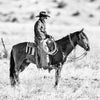
Teal Blake Biography
Teal Blake grew up in Montana, on the eastern slope of the Rocky Mountains, surrounded by ranching country. Growing up in his father’s studio, looking at C. M. Russell paintings and reading Will James books, it was hard not to pick up a pencil and start capturing his own visions of cowboys and the American West. His father’s artist friends, Cary Carter, William Mathews, Vel Miller and Dave Powell, were frequent visitors to the Blake home and studio. Young Teal listened in on their conversations, which were usually about western art.
Teal has always liked to show what makes the traditional west: cowboys not always clean shaven; shirts not always creased; and their horses' manes not always long.
Broncs tend to get the most attention, maybe because the bucking horse has always been one of the most recognized symbols of the West. Teal’s medium of choice is watercolor.
Viewing Carlie Russell paintings at the Russell Museum in Great Falls, Montana, helped the young artists see that cowboys were seldom clean-shaved, their shirts weren’t always creased and clean, and horses manes weren’t long.
“An artist sees the big picture, rather than the imperfections,” Teal says. “Overall, art is not copying the image in detail, but telling the story with feeling. That’s one of the main attributes of western art – it’s honest.”
Teal’s heritage is more than having an artist for a father. His mother is a photographer and journalist, and his great-grandfather, Samuel Coke Blake, was one of the American Quarter Horse’s founding breeders. The Blake family continues to raise Quarter Horses for cutting and roping, and Teal competes in both events.
Bucking horses have always been a favorite for Teal. They represent the timeless battle between man and animal, he says. “There’s a feeling when you watch a young horse blow up, you tend to remember something about him. It might be his color or a marking, and when you see that horse later working cattle, being used or standing hobbled at a branding, it’s not a conquering feeling but a handshake, kind of an agreement. Where would the cowboy be without his horse?
“There are many great cowboys who epitomize the American cowboy stereotype,” Teal says. “You recognize them right away. They just seem to have cowboy written all over them.
A few years ago, Teal moved from Idaho to Texas to be more centrally located in the horse world. He’s found Texas to be its own country with an immense history and tradition, and he’s grateful for having the opportunity to visit some of Texas’ large ranches, where he works during brandings and fall gathers. It’s this experience that enables him to duplicate the true American West.




